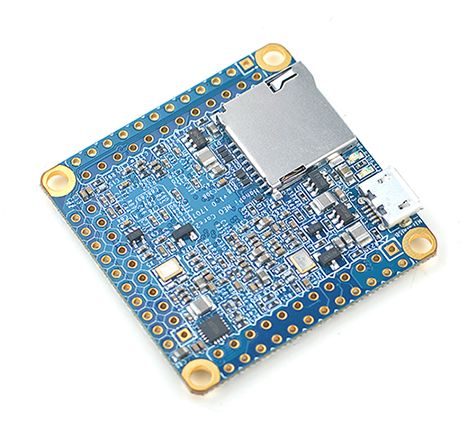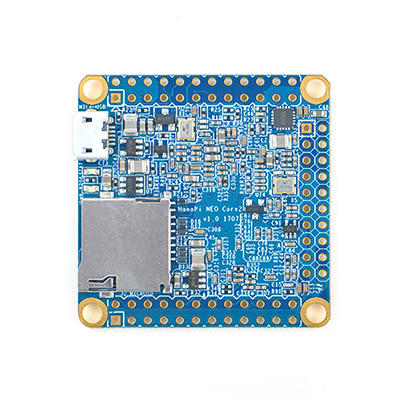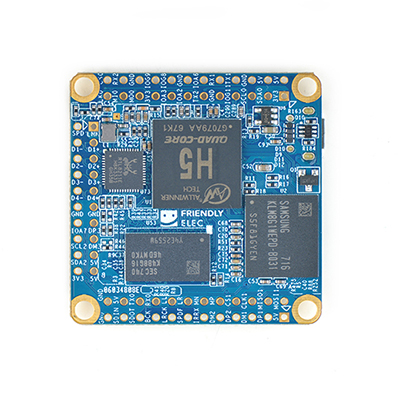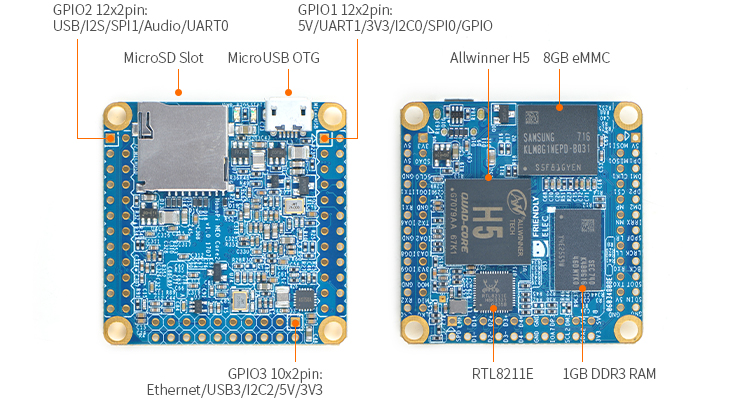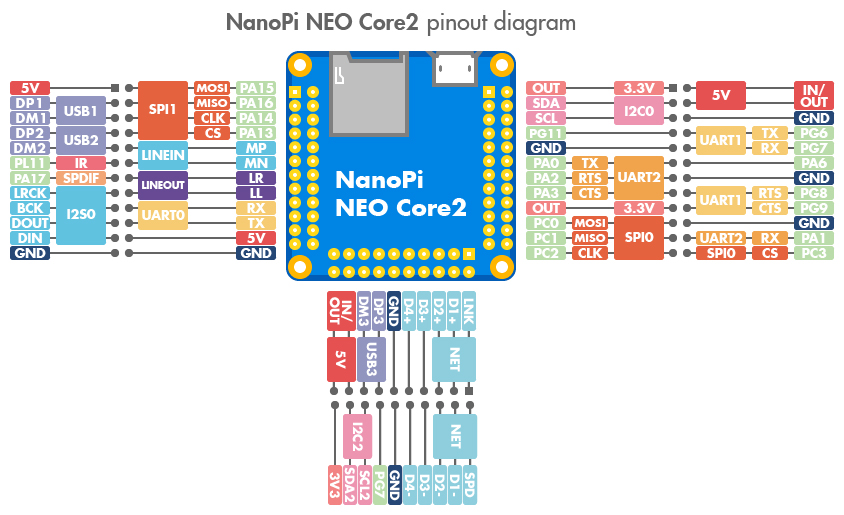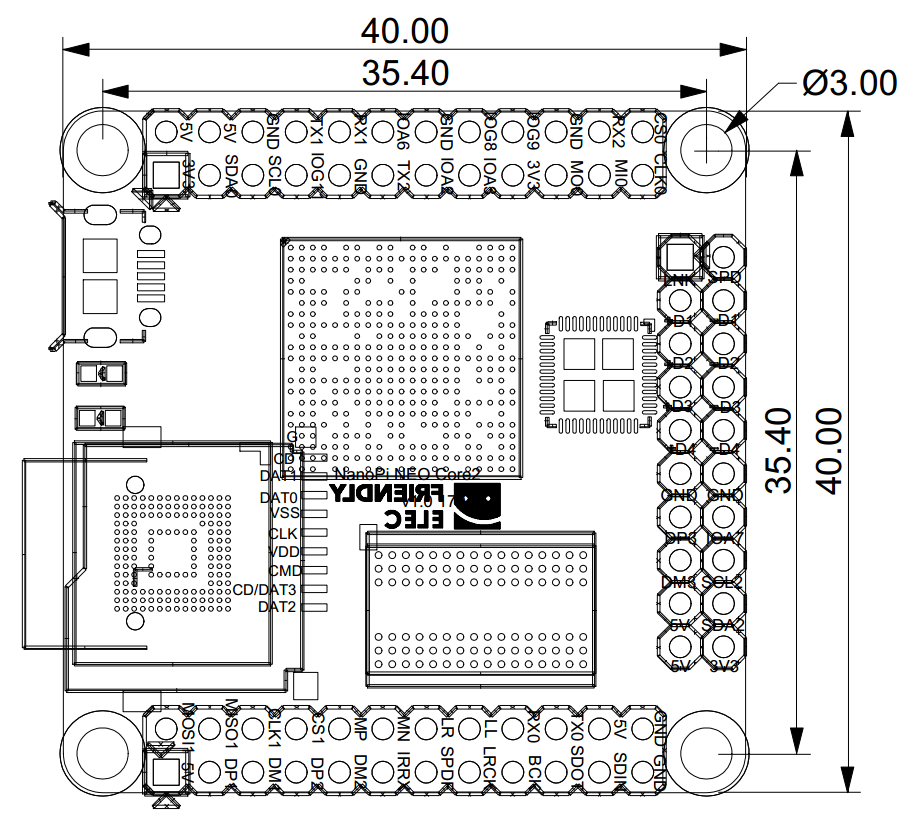Difference between revisions of "NanoPi NEO Core2"
(updated by API) |
(updated by API) |
||
| Line 150: | Line 150: | ||
|colspan=2|Image Files: | |colspan=2|Image Files: | ||
|- | |- | ||
| − | |nanopi-neo- | + | |nanopi-neo-core2_friendlycore-xenial_4.x.y_YYYYMMDD.img.zip || FriendlyCore (base on UbuntuCore) Image File, Kernel: Linux-4.x.y |
|- | |- | ||
|nanopi-neo-core2_eflasher_4.x.y_YYYYMMDD.img.zip || eflasher Image File, Kernel: Linux-4.x.y | |nanopi-neo-core2_eflasher_4.x.y_YYYYMMDD.img.zip || eflasher Image File, Kernel: Linux-4.x.y | ||
Revision as of 08:48, 22 December 2017
Contents
- 1 Introduction
- 2 Hardware Spec
- 3 Diagram, Layout and Dimension
- 4 Get Started
- 5 Work with Ubuntu-Core with Qt-Embedded
- 5.1 Run Ubuntu-Core with Qt-Embedded
- 5.2 Extend NEO Core2's TF Card Section
- 5.3 Configure System with npi-config
- 5.4 Ethernet Connection
- 5.5 Connect USB WiFi to NEO Core2
- 5.6 Login via SSH
- 5.7 Connect NanoPi NEO Core2 to USB Camera(FA-CAM202)
- 5.8 Play & Record Audio
- 5.9 Access GPIO Pins/Wirings with WiringNP
- 6 Make Your Own Ubuntu-Core with Qt-Embedded
- 7 Connect External Modules to NEO Core2
- 7.1 Connect Python Programmable NanoHat OLED to NEO Core2
- 7.2 Connect Python Programmable NanoHat Motor to NEO Core2
- 7.3 Connect NanoHat PCM5102A to NEO Core2
- 7.4 Connect Arduino Compatible UNO Dock to NEO Core2
- 7.5 Connect NanoHat Proto to NEO Core2
- 7.6 Connect Matrix - 2'8 SPI Key TFT to NanoPi NEO Core2
- 8 3D Printing Files for Housing
- 9 Resources
- 10 Update Log
1 Introduction
- The NanoPi NEO Core2 as its name tells is an alternative NanoPi NEO2 that works like a CPU board with male pin-headers. It has the same form facotor as the NanoPi NEO2, same pin descriptions and works with all the OS images the NanoPi NEO2 supports. The connectors and ports on the NEO2 are populated to pin-headers on the NEO2 Core. In addition the NEO Core2 can have an optional onboard eMMC flash and ESD protection for connectors and ports. There features are highly preferred by industrial customers.
- The NEO2 Core uses a popular Allwinner H5 SoC and has onboard 1G DDR3 RAM. FriendlyElec offers models with three eMMC options: 8GB(default)/16GB/32GB. FriendlyElec migrated UbuntuCore with mainline kernel 4.11 for it. It works with other OS such as Armbian as well. Compared to the NanoPi NEO2 the NanoPi NEO Core2 runs more reliably with much less overheat. It is a good platform for IoT applications, mornitoring systems, smart control systems, cluster computing and AI applications.
- FriendlyElec develops a Mini Shield for NanoPi NEO Core/Core2 which has the same form factor as the RPi 3. When a NanoPi NEO Core2 is connected to this Mini Shield the whole assembled module can be well fit into a common RPi 3's case.
2 Hardware Spec
- CPU: Allwinner H5, Quad-core 64-bit high-performance Cortex A53
- DDR3 RAM: 512MB/1GB
- Storage: 8GB/16GB/32GB eMMC
- Connectivity: 10/100/1000M Ethernet utilizing RTL8211E-VB-CG
- USB Host x 3(included in 2.54mm pitch pin header)
- MicroSD Slot x 1
- LED: x 2, one for power status and the other for system status
- GPIO1: 2.54mm pitch 12 x 2 pin header containing UART, SPI, I2C, GPIO and etc
- GPIO2: 2.54mm pitch 24 pin header containing SPI, IR, I2S, USB, serial debug port, audio and etc
- GPIO3: 2.54mm pitch 20 pin header containing USB, Gbps Ethernet, I2C and etc
- PCB Size: 40 x 40mm
- MicroUSB: OTG and power input
- OS/Software: u-boot,Ubuntu Core
- Weight: xxg(Without Pin-headers)
3 Diagram, Layout and Dimension
3.1 Layout
- GPIO1 Pin Description
Pin# Name Linux gpio Pin# Name Linux gpio 1 SYS_3.3V 2 VDD_5V 3 I2C0_SDA / GPIOA12 12 4 VDD_5V 5 I2C0_SCL / GPIOA11 11 6 GND 7 GPIOG11 203 8 UART1_TX / GPIOG6 198 9 GND 10 UART1_RX / GPIOG7 199 11 UART2_TX / GPIOA0 0 12 GPIOA6 6 13 UART2_RTS / GPIOA2 2 14 GND 15 UART2_CTS / GPIOA3 3 16 UART1_RTS / GPIOG8 200 17 SYS_3.3V 18 UART1_CTS / GPIOG9 201 19 SPI0_MOSI / GPIOC0 64 20 GND 21 SPI0_MISO / GPIOC1 65 22 UART2_RX / GPIOA1 1 23 SPI0_CLK / GPIOC2 66 24 SPI0_CS / GPIOC3 67
- GPIO2 Pin Description
Pin# Name Description Pin# Name Description 1 VDD_5V 2 MOSI1 SPI1-MOSI 2 USB-DP1 USB1 DP Signal 4 MISO1 SPI1-MISO 3 USB-DM1 USB1 DM Signal 6 CLK1 SPI1-CLK 4 USB-DP2 USB2 DP Signal 8 CS1 SPI1-CS 5 USB-DM2 USB2 DM Signal 10 MP Microphone Positive Input 6 GPIOL11 / IR-RX GPIOL11 or IR Receive 12 MN Microphone Negative Input 7 SPDIF-OUT / GPIOA17 GPIOA17 or SPDIF-OUT 14 LR LINE-OUT Right Channel Output 8 PCM0_SYNC / I2S0_LRCK/I2C1_SCL I2S/PCM Sample Rate Clock/Sync 16 LL LINE-OUT Left Channel Output 9 PCM0_CLK / I2S0_BCK/I2C1_SDA I2S/PCM Sample Rate Clock 18 RXD UART_RXD0/GPIOA5/PWM0 10 PCM0_DOUT / I2S0_SDOUT I2S/PCM Serial Bata Output 20 TXD UART_TXD0/GPIOA4 11 PCM0_DIN / I2S0_SDIN I2S/PCM Serial Data Input 22 VDD_5V 12 GND 0V 24 GND 0V
- GPIO3 Pin Description
Pin# Name Description Pin# Name Description 1 LINK-LED Ethernet Link LED 2 SPEED-LED Ethernet Speed LED 2 TRD1+ Ethernet TRD1+ Signal 4 TRD1- Ethernet TRD1- Signal 3 TRD2+ Ethernet TRD2+ Signal 6 TRD2- Ethernet TRD2- Signal 4 TRD3+ Ethernet TRD3+ Signal 8 TRD3- Ethernet TRD3- Signal 5 TRD4+ Ethernet TRD4+ Signal 10 TRD4- Ethernet TRD4- Signal 6 GND 0V 12 GND 0V 7 USB-DP3 GPIOA17 or SPDIF-OUT 14 GPIOA7 8 USB-DM2 I2S/PCM Sample Rate Clock/Sync 16 I2C2-SDA 9 VDD_5V 5V Power Out 18 I2C2-SCL 10 VDD_5V 5V Power Out 20 VDD_3.3V 3.3V Power Outt
- Note:
- SYS_3.3V: 3.3V power output
- VVDD_5V: 5V power input/output. When the external device’s power is greater than the MicroUSB's the external device is charging the board otherwise the board powers the external device. The input range is 4.7V ~ 5.6V
- All pins are 3.3V, output current is 5mA
- For more details refer to its schematic: NanoPi NEO Core2-1707-Schematic.pdf
3.2 Dimensional Diagram
- For more details refer to the document:pcb in dxf format
4 Get Started
4.1 Essentials You Need
Before starting to use your NanoPi NEO Core2 get the following items ready
- NanoPi NEO Core2
- microSD Card/TF Card: Class 10 or Above, minimum 8GB SDHC
- microUSB power. A 5V/2A power is a must
- A Host computer running Ubuntu 16.04 64 bit system
4.2 TF Cards We Tested
To make your NanoPi NEO Core2 boot and run fast we highly recommend you use a Class10 8GB SDHC TF card or a better one. The following cards are what we used in all our test cases presented here:
- SanDisk TF 8G Class10 Micro/SD TF card:
- SanDisk TF128G MicroSDXC TF 128G Class10 48MB/S:
- 川宇 8G C10 High Speed class10 micro SD card:
4.3 Make an Installation TF Card
4.3.1 Get Image Files
Visit this link download link to download image files and the flashing utility:
Image Files: nanopi-neo-core2_friendlycore-xenial_4.x.y_YYYYMMDD.img.zip FriendlyCore (base on UbuntuCore) Image File, Kernel: Linux-4.x.y nanopi-neo-core2_eflasher_4.x.y_YYYYMMDD.img.zip eflasher Image File, Kernel: Linux-4.x.y Flash Utility: win32diskimager.rar Windows utility for flashing Debian image. Under Linux users can use "dd"
4.3.2 Make Bootable TF Card
4.3.2.1 Make UbuntuCore with Qt Embedded Image Card
- Extract the image file and win32diskimager.rar files. Insert a TF card(at least 8G) into a Windows PC and run the win32diskimager utility as administrator. On the utility's main window select your TF card's drive, the wanted image file and click on "write" to start flashing the TF card.
- After flashing is done insert this TF card to your NanoPi NEO Core2 and connect the board to a 5V/2A power NEO Core2 will be automatically powered on. If the green LED is solid on and the blue LED is flashing it indicates the system is being booted.
Note: this method applies to making a bootable TF card with Debian too.
4.3.3 Flash OS to eMMC
- Extract the image file and win32diskimager.rar files. Insert a TF card(at least 8G) into a Windows PC and run the win32diskimager utility as administrator. On the utility's main window select your TF card's drive, the wanted image file and click on "write" to start flashing the TF card.
- After flashing is done insert this TF card to your NanoPi NEO Core2 and connect the board to a 5V/2A power NEO Core2 will be automatically powered on. If the green LED is solid on and the blue LED is flashing it indicates the system is being booted.
- Run the following commands in a terminal to flash OS to eMMC:
$ su root
$ eflasherThe password for "root" is "fa". Type a number and press "enter" to select an OS you want to flash and then type "yes" and press "enter" to start flashing:

After it is done power off the board and take out the TF card. Power on the board again and your board will boot from eMMC.
5 Work with Ubuntu-Core with Qt-Embedded
5.1 Run Ubuntu-Core with Qt-Embedded
- If you want to do kernel development you need to use a serial communication board, ie a PSU-ONECOM board, which will allow you to operate the board via a serial terminal.
PSU-ONECOM-NEO-Core2
Or you can use a USB to serial board to debug the system. Here is a hardware setup:
USB2UART-NEO-Core2
- Here is a setup where we connect a NanoPi NEO Core to a Mini Shield for NanoPi NEO Core/Core2. Here is an introduction to Mini Shield for NanoPi NEO Core/Core2 Mini Shield
:
Mini Shield for NanoPi NEO Core/Core2 和 Core2
- Ubuntu-Core's User Accounts:
Non-root User:
User Name: pi Password: pi
root:
User Name: root Password: fa
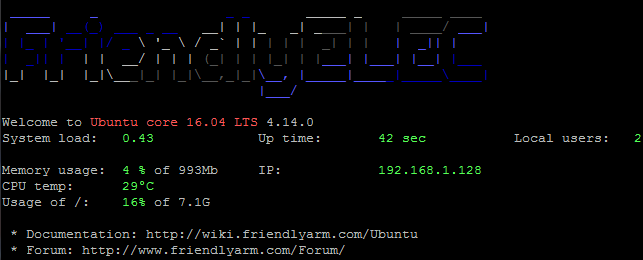
The system is automatically logged in as "pi". You can do "sudo npi-config" to disable auto login.
- Update packages
$ sudo apt-get update
5.2 Extend NEO Core2's TF Card Section
When Ubuntu is loaded the TF card's section will be automatically extended.You can check the section's size by running the following command:
$ df -h
5.3 Configure System with npi-config
The npi-config is a commandline utility which can be used to initialize system configurations such as user password, system language, time zone, Hostname, SSH switch , Auto login, hardware interface(Serial/I2C/SPI/PWM/I2S) and etc. Type the following command to run this utility.
$ sudo npi-config
Here is how npi-config's GUI looks like:

5.4 Ethernet Connection
If a NanoPi NEO Core2 is connected to a network via Ethernet before it is powered on it will automatically obtain an IP after it is powered up. If it is not connected via Ethernet or its DHCP is not activated obtaining an IP will fail and system will hang on for about 15 to 60 seconds. In this case you can try obtaining an IP by using the following command
dhclient eth0
5.5 Connect USB WiFi to NEO Core2
Our system has support for popular USB WiFi drivers. Many USB WiFi modules are plug and play with our system. Here is a list of models we tested;
Number Model 1 RTL8188CUS/8188EU 802.11n WLAN Adapter 2 RT2070 Wireless Adapter 3 RT2870/RT3070 Wireless Adapter 4 RTL8192CU Wireless Adapter 5 MI WiFi mt7601
If you NanoPi NEO Core2 is connected to a USB WiFi and is powered up you can log into NEO Core2 and run the following command to check if the USB WiFi is recognized. If "wlan0" is listed it indicates your USB WiFi has been recognized:
$ sudo ifconfig -a
You can use the NetworkManager utility in Ubuntu to manager its network. You can run "nmcli" in the commandline utility to start it. Here are the commands to start a WiFi connection:
- Check device list
$ sudo nmcli dev
Note: if the status of a device is "unmanaged" it means that device cannot be accessed by NetworkManager. To make is accessed you need to clear the settings under "/etc/network/interfaces" and reboot your system.
- Start WiFi
$ sudo nmcli r wifi on
- Scan Surrounding WiFi Sources
$ sudo nmcli dev wifi
- Connect to a WiFi Source
$ sudo nmcli dev wifi connect "SSID" password "PASSWORD"
The "SSID" and "PASSWORD" need to be replaced with your actual SSID and password.If you have multiple WiFi devices you need to specify the one you want to connect to a WiFi source with iface
If a connection succeeds it will be automatically setup on next system reboot.
For more details about NetworkManager refer to this link: Use NetworkManager to configure network settings
5.6 Login via SSH
The NanoPi NEO Core2 doesn't have a video output interface. You can log into the board via SSH. In our test the IP address detected by our router was 192.168.1.230 and we ran the following command to log into the NanoPi NEO Core2:
$ ssh root@192.168.1.230
The password is fa
5.7 Connect NanoPi NEO Core2 to USB Camera(FA-CAM202)
USB camera
The FA-CAM202 is a 2M-pixel USB camera module.
Boot your NEO Core2, connect NEO Core2 to the internet, log in the system as root, compile and run the mjpg-streamer utility:
$ su root $ cd /root/mjpg-streamer $ make $ ./start.sh
The mjpg-streamer is an open source media server. After it is started successfully you will see the following messages:
i: Using V4L2 device.: /dev/video0 i: Desired Resolution: 1280 x 720 i: Frames Per Second.: 30 i: Format............: YUV i: JPEG Quality......: 90 o: www-folder-path...: ./www/ o: HTTP TCP port.....: 8080 o: username:password.: disabled o: commands..........: enabled
In our case our NEO Core2's IP address was 192.168.1.123. We typed "192.168.1.123:8080" on a browser, entered and we got the following screenshot:
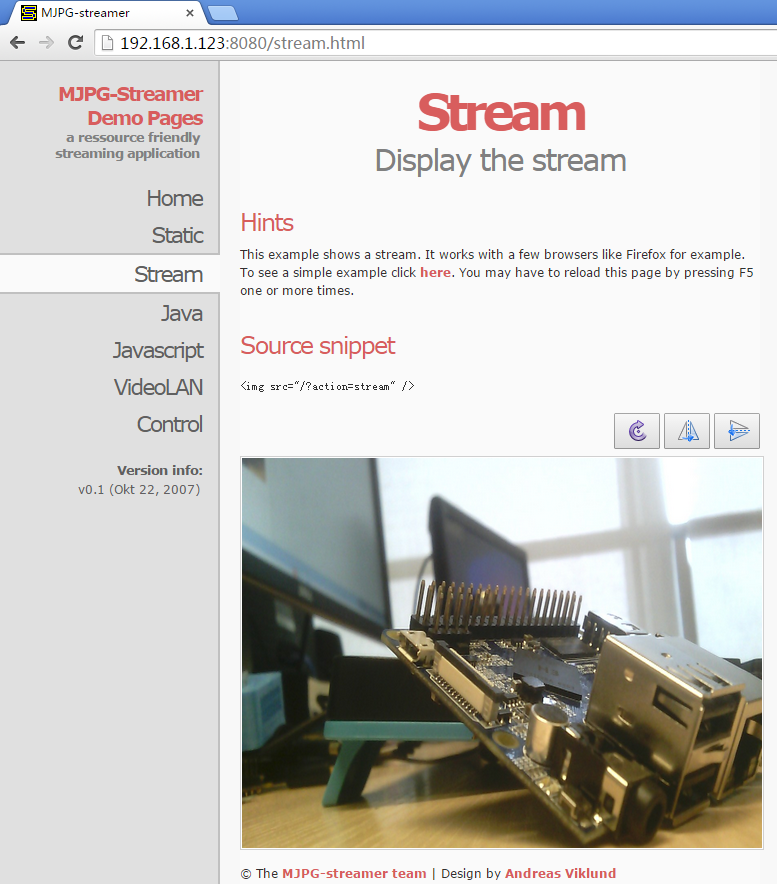
5.8 Play & Record Audio
Core2's audio interface is populated to a 2.54mm pitch pin-header. Here is the pin description:
Pin# Name Description 1 MICIN1P Microphone Positive Input 2 MICIN1N Microphone Negative Input 3 LINEOUTR LINE-OUT Right Channel Output 4 LINEOUTL LINE-OUT Left Channel Output
Here is a hardware setup for connecting an audio device to a NanoPi NEO Core2:
耳麦标注
Make sure an audio device is connected to your NEO Core2 and you can play and record audio by running the following commands.
List audio device:
$ aplay -l **** List of PLAYBACK Hardware Devices **** card 0: Codec [H3 Audio Codec], device 0: CDC PCM Codec-0 [] Subdevices: 1/1 Subdevice #0: subdevice #0
Both Allwinner H5 and H3 have a codec device which is recognized in the kernel as [H3 Audio Codec].
Play audio:
$ aplay /root/Music/test.wav -D plughw:0
Record audio:
$ arecord -f cd -d 5 test.wav
5.9 Access GPIO Pins/Wirings with WiringNP
The wiringPi library was initially developed by Gordon Henderson in C. It contains libraries to access GPIO, I2C, SPI, UART, PWM and etc.
The wiringPi library contains various libraries, header files and a commandline utility:gpio. The gpio utility can be used to read and write GPIO pins.
FriendlyElec integrated this utility in NEO Core's system allowing users to easily access GPIO pins. For more details refer to WiringNP
6 Make Your Own Ubuntu-Core with Qt-Embedded
6.1 Use Mainline BSP
The NanoPi NEO Core2 works with a 64-bit Linux kernel and 64-bit UbuntuCore 16.04. For more details about how to use mainline u-boot and Linux-4.x.y refer to :Mainline U-boot & Linux
6.2 Use Allwinner's BSP
6.2.1 Preparations
Visit this link download link and enter the "sources/nanopi-h5-bsp" directory and download all the source code.Use the 7-zip utility to extract it and a lihee directory and an Android directory will be generated.You can check that by running the following command:
$ ls ./ android lichee
Or you can get it from our github:
$ git clone https://github.com/friendlyarm/h3_lichee.git lichee
Note: "lichee" is the project name named by Allwinner for its CPU's source code which contains the source code of U-boot, Linux kernel and various scripts.
6.2.2 Install Cross Compiler
Visit this site download link, enter the "toolchain" directory, download the cross compiler gcc-linaro-arm-4.6.3.tar.xz and gcc-linaro-aarch64.tar.xz and copy them to the "lichee/brandy/toochain/" directory.
The gcc-linaro-arm-4.6.3.tar.xz compiler is used to compile u-boot and gcc-linaro-aarch64.tar.xz is used to compile a Linux kernel.
6.2.3 Compile lichee Source Code
Compilation of the H5's BSP source code must be done under a PC running a 64-bit Linux.The following cases were tested on Ubuntu-14.04 LTS-64bit:
$ sudo apt-get install gawk git gnupg flex bison gperf build-essential \ zip curl libc6-dev libncurses5-dev:i386 x11proto-core-dev \ libx11-dev:i386 libreadline6-dev:i386 libgl1-mesa-glx:i386 \ libgl1-mesa-dev g++-multilib mingw32 tofrodos \ python-markdown libxml2-utils xsltproc zlib1g-dev:i386
Enter the lichee directory and un the following command to compile the whole package:
$ cd lichee/fa_tools $ ./build.sh -b nanopi-neo2 -p linux -t all
After this compilation succeeds a u-boot, Linux kernel and kernel modules will be generated.
Note: the lichee directory contains a cross-compiler we have setup. When the build.sh script runs it will automatically call this cross-compiler.
Type the following command to update the U-boot on your TF card:
$ cd lichee/fa_tools/ $ ./fuse.sh -d /dev/sdX -p linux -t u-boot
Note: you need to replace "/dev/sdx" with the device name in your system.
The boot.img and kernel modules are under the "linux-3.10/output" directory. You can copy the new boot.img file to your TF card's boot section.
6.3 Compile U-boot
Note:before you can compile u-boot individually you need to compile the whole lichee directory. You can compile u-boot individually by using the following command:
$ cd lichee/fa_tools/ $ ./build.sh -b nanopi-neo2 -p linux -t u-boot
Type the following command to update the U-boot on your TF card:
$ cd lichee/fa_tools/ $ ./fuse.sh -d /dev/sdX -p linux -t u-boot
Note: you need to replace "/dev/sdx" with the device name in your system.
6.4 Compile Linux Kernel
If you want to compile the Linux kernel run the following command:
$ cd lichee/fa_tools/ $ ./build.sh -b nanopi-neo2 -p linux -t kernel
After the compilation is done a uImage and its kernel modules will be generated under "linux-3.10/output".
6.5 Clean Source Code
$ cd lichee/fa_tools/ $ ./build.sh -b nanopi-neo2 -p linux -t clean
7 Connect External Modules to NEO Core2
7.1 Connect Python Programmable NanoHat OLED to NEO Core2
The NanoHat OLED module is a small and cute monochrome OLED module with low power consumption. It has three user buttons. We provide its driver's source code and a user friendly shell interface on which you can check system information and status.A customized aluminum case is made for it. You cannot miss this lovely utility! Here is a hardware setup:NanoHat OLED
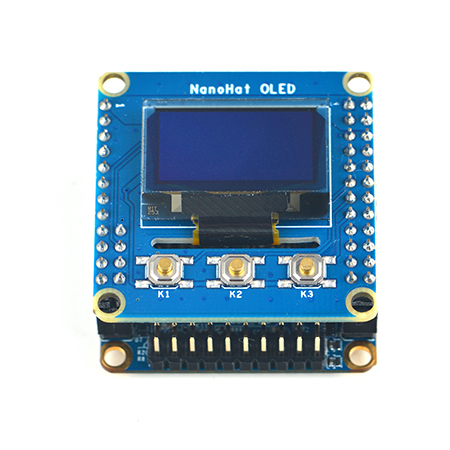
7.2 Connect Python Programmable NanoHat Motor to NEO Core2
The NanoHat Motor module can drive four 5V PWM steering motors and four 12V DC motors or four 5V PWM steering motors and two 12V four-wire step motors.Here is a hardware setup: NanoHat Motor
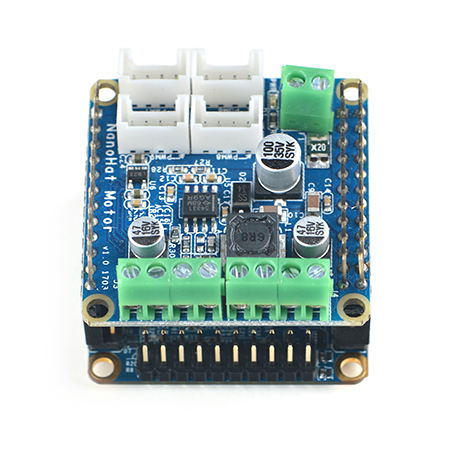
7.3 Connect NanoHat PCM5102A to NEO Core2
The NanoHat PCM5102A module uses TI's DAC audio chip PCM5102A, a convenient and easy-to-use audio module for hobbyists. Here is a hardware setup:NanoHat PCM5102A
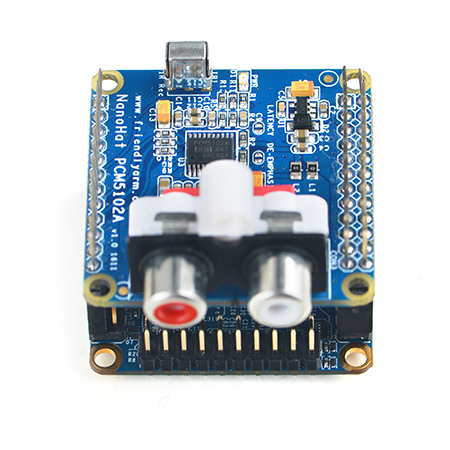
7.4 Connect Arduino Compatible UNO Dock to NEO Core2
The UNO Dock module is an Arduino board compatible with Arduino UNO and works with Arduino programs.You can use Arduino IDE to run all Arduino programs on the Dock.It also exposes the NanoPi NEO Core2's pins.It converts 12V power input to 5V/2A output.You can search for various code samples from Ubuntu's ecosystem and run on the Dock. These features make it a powerful platform for IOT projects and cloud related applications. Here is a hardware setup:UNO Dock for NanoPi NEO v1.0
Matrix-UNO_Dock_NEO_Core2
7.5 Connect NanoHat Proto to NEO Core2
The NanoHat Proto is an expansion board which exposes NEO Core2's various pins.It has an onboard EEPROM for data storage.Here is a hardware setup:NanoHat Proto
Matrix - NanoHat Proto_nanopi_NEO_Core2
7.6 Connect Matrix - 2'8 SPI Key TFT to NanoPi NEO Core2
The Matrix-2'8_SPI_Key_TFT module is a 2.8" TFT LCD with resistive touch. It uses the ST7789S IC and XPT2046 resistive touch IC. It has SPI interface and three configurable user keys.Here is its wiki page Matrix - 2'8 SPI Key TFT
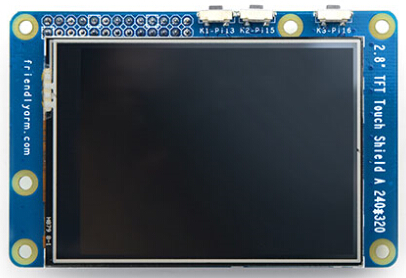
8 3D Printing Files for Housing
9 Resources
9.1 Datasheet & Schematic
- Schematic
- Dimensional diagram
- H5 datasheet Allwinner_H5_Datasheet_V1.0.pdf
10 Update Log
10.1 Dec-1-2017
- Released English version
